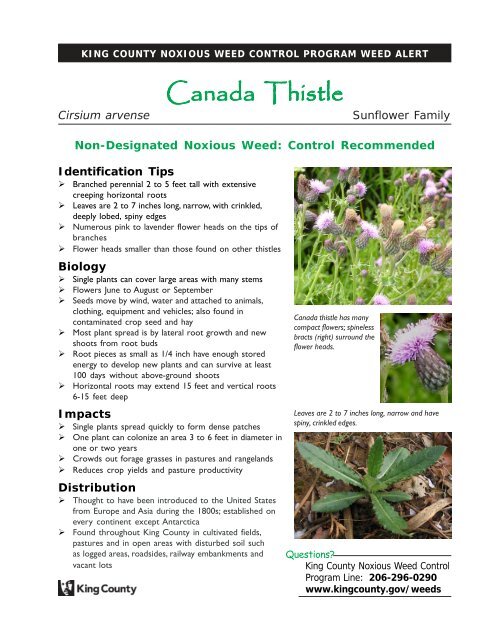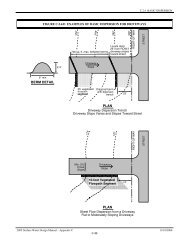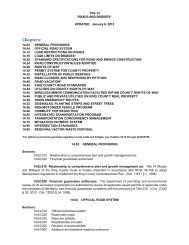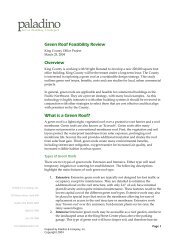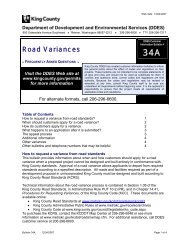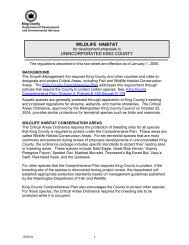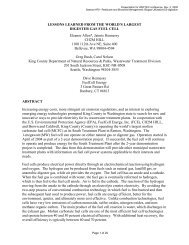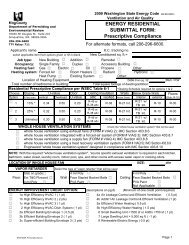Canada Thistle (Cirsium arvense) - King County Noxious Weed Alert
Canada Thistle (Cirsium arvense) - King County Noxious Weed Alert
Canada Thistle (Cirsium arvense) - King County Noxious Weed Alert
You also want an ePaper? Increase the reach of your titles
YUMPU automatically turns print PDFs into web optimized ePapers that Google loves.
KING COUNTY NOXIOUS WEED CONTROL PROGRAM WEED ALERT<br />
<strong>Canada</strong> <strong>Thistle</strong><br />
<strong>Cirsium</strong> <strong>arvense</strong> Sunflower Family<br />
Non-Designated <strong>Noxious</strong> <strong>Weed</strong>: Control Recommended<br />
Identification Tips<br />
‣ Branched perennial 2 to 5 feet tall with extensive<br />
creeping horizontal roots<br />
‣ Leaves are 2 to 7 inches long, narrow, with crinkled,<br />
deeply lobed, spiny edges<br />
‣ Numerous pink to lavender flower heads on the tips of<br />
branches<br />
‣ Flower heads smaller than those found on other thistles<br />
Biology<br />
‣ Single plants can cover large areas with many stems<br />
‣ Flowers June to August or September<br />
‣ Seeds move by wind, water and attached to animals,<br />
clothing, equipment and vehicles; also found in<br />
contaminated crop seed and hay<br />
‣ Most plant spread is by lateral root growth and new<br />
shoots from root buds<br />
‣ Root pieces as small as 1/4 inch have enough stored<br />
energy to develop new plants and can survive at least<br />
100 days without above-ground shoots<br />
‣ Horizontal roots may extend 15 feet and vertical roots<br />
6-15 feet deep<br />
Impacts<br />
‣ Single plants spread quickly to form dense patches<br />
‣ One plant can colonize an area 3 to 6 feet in diameter in<br />
one or two years<br />
‣ Crowds out forage grasses in pastures and rangelands<br />
‣ Reduces crop yields and pasture productivity<br />
Distribution<br />
‣ Thought to have been introduced to the United States<br />
from Europe and Asia during the 1800s; established on<br />
every continent except Antarctica<br />
‣ Found throughout <strong>King</strong> <strong>County</strong> in cultivated fields,<br />
pastures and in open areas with disturbed soil such<br />
as logged areas, roadsides, railway embankments and<br />
vacant lots<br />
<strong>Canada</strong> thistle has many<br />
compact flowers; spineless<br />
bracts (right) surround the<br />
flower heads.<br />
Leaves are 2 to 7 inches long, narrow and have<br />
spiny, crinkled edges.<br />
Questions<br />
<strong>King</strong> <strong>County</strong> <strong>Noxious</strong> <strong>Weed</strong> Control<br />
Program Line: 206-296-0290<br />
www.kingcounty.gov/weeds
What You Can Do<br />
In <strong>King</strong> <strong>County</strong>, <strong>Canada</strong> thistle is already so widespread that requiring control would not be feasible.<br />
However, the <strong>King</strong> <strong>County</strong> <strong>Noxious</strong> <strong>Weed</strong> Control Board recommends controlling <strong>Canada</strong> thistle<br />
whenever possible.<br />
Control Methods<br />
For best results, control methods should be employed throughout several growing seasons. The key<br />
principle in <strong>Canada</strong> thistle control is to reduce the root mass by stressing the plant and forcing it to<br />
use stored root nutrients.<br />
Manual: Although seedlings are easily removed, digging established plants is not practical because of<br />
the far-reaching horizontal roots and deep vertical ones. For best results, cut plants when they have the<br />
least root reserves and have formed tight green buds (usually by June). Cut the regrowth each time<br />
buds appear again. This approach will weaken the roots over time. For new infestations, carefully dig<br />
up young plants before they become established. Make sure to remove all mature seed heads so no<br />
new seeds are left on the site.<br />
Mechanical: Do not cultivate or till until plants have been controlled. Each root fragment can grow<br />
into a new plant. Mowing and clipping at the bud stage can be effective, and should be repeated on<br />
regrowth to weaken roots. Combining fall herbicide treatment on regrowth after mowing has been<br />
effective. Mowing once a year is not effective. Also, seeds can develop 8-10 days after flowers open, so<br />
mowing before buds open is best. Clean equipment and avoid spreading mature seeds and/or root<br />
fragments to un-infested areas.<br />
Cultural: Maintain healthy, competitive grasses in pastures by fertilizing and using proper pasture<br />
management techniques. Avoid over-grazing and mow thistles after grazing. Seed or plant disturbed or<br />
open areas. If closely monitored, goats and sheep can be used to manage thistle.<br />
Chemical: Follow label directions and only use products appropriate and legal for the site and at rates<br />
specified on the label. Some herbicides have restrictions when pastures are grazed, especially by<br />
lactating dairy animals. Addition of a suitable surfactant to the spray mix will improve control. In pastures,<br />
use selective broadleaf herbicides that won’t harm grasses. Avoid spraying drought-stressed<br />
plants or just before a hard frost. Effectiveness of herbicides is increased when roots are weakened by<br />
mowing or previous treatments. Control entire infestation since roots will spread from uncontrolled<br />
areas into adjacent controlled areas.<br />
Triclopyr (Garlon), 2,4-D, and combination products such as 2,4-D+dicamba (<strong>Weed</strong>master) or 2,4-D+<br />
triclopyr (Crossbow) are most effective applied at or just before bud stage. Soil-active selective broadleaf<br />
herbicides containing dicamba (Banvel), clopyralid (Stinger) and aminopyralid (Milestone) and<br />
combination products clopyralid+2,4-D (Curtail) and clopyralid+ triclopyr (Redeem R&P) work well<br />
when applied to actively growing thistles in spring pre-bud or in fall (these soil-active herbicides<br />
should be used only in pastures and non-crop areas). Glyphosate (Round-up), is very effective when<br />
applied after the bud stage until fall frost, but is non-selective and will kill grasses. Wait at least three<br />
days to cut or till plants treated with glyphosate.<br />
The mention of a specific product brand name in this document is not,<br />
and should not be construed as an endorsement or as a<br />
recommendation for the use of that product.<br />
Revised April 2007


